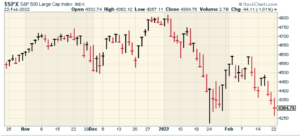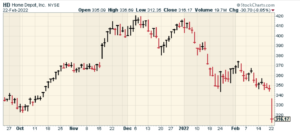CWS Market Review – February 22, 2022
(This is the free version of CWS Market Review. If you like what you see, then please sign up for the premium newsletter for $20 per month or $200 for the whole year. If you sign up today, you can see our two reports, “Your Handy Guide to Stock Orders” and “How Not to Get Screwed on Your Mortgage.”)
War and the Stock Market
The headlines have been dominated by war news from Eastern Europe. As I write this, Russian troops have moved across the border into Ukraine. Let me be clear that this news is not be a cause for you to sell out of the market, particularly any of our Buy List stocks.
I’m hardly a national security expert, so I’ll avoid any commentary on that. However, I will touch upon the long and troubling relationship between war and financial markets.
In fact, it’s not a stretch to say that the growth of modern financial markets is a byproduct of war. When countries have had to raise enormous sums of money to keep the battle going, that has spurred the development of financial centers that could sell war bonds at fantastic rates.
At the outset of World War I, the British government thought it could pay for the war with existing revenues. That wasn’t the case. It was the need for funds, particularly in our Civil War, that created the infrastructure that could later be used to raise money for large-scale corporate ventures.
Here’s a famous photo of Charlie Chaplin being held aloft by Douglas Fairbanks at a Liberty bond drive in 1918:

That bond drive was for $4.1 billion at 4.15%.
One hundred years later, at the exact same spot, your humble editor tries to mimic Chaplin’s gesture:

War, sadly, is big business and it’s often good business, especially if you win. The line attributed to Nathan Rothschild is that one should “buy on drums and sell on trumpets,” meaning to buy at the start of a war and sell once peace returns. In 2003, the stock market reached its bottom right as the fighting started.
During World War II, the stock market fell from Pearl Harbor until April 1942. The ultimate low came on April 28, ten days after the daring Doolittle Raid over Tokyo. The Dow closed at 92.92. To add some context, on September 3, 1929, the Dow had been at 386. So more than twelve years after the peak, the stock market was still about a quarter of where it had been.
The war, however, spurred a big rally for stocks. Within two years, the Dow was up 50%, and it doubled by 1945. By 1955, the Dow was up fivefold, and it doubled again ten years later. The market really didn’t see any pause until 1966 when inflation started to have a major impact. Twenty-four years after FDR’s “Day of Infamy” speech, the Dow had advanced close to 1,000%, and that’s not counting dividends.
At the outbreak of WWI, the stock exchange shut down. They didn’t think it was going to last long. Traders soon started meeting in the street outside the exchange. The NYSE finally relented and trading resumed indoors in November 1914.
What about after the war? Post-war periods have often been associated with ugly bouts of inflation. That’s when the loose money policies come due. Many people remember the persistent inflation of the 1970s, but the post WW2 inflation seems to have been lost down the memory hole. In 1946, inflation was 8.3% and the following year, it got to 14.4%. You rarely hear about that but that’s what happens when you hold back demand for a few years.
Here’s an amazing stat. During World War II, how many cars did America make? The answer is 139. Compare that to the year just before America entered the war, 1941, when we made three million.
I was recently on Michael Gayed’s podcast and I said that in many ways, dealing with Covid has been similar, in an economic sense, to going to war. Not in a literal sense, of course, but the government and the Federal Reserve went to extreme lengths to keep the economy afloat.
In this case, we already had inflation at the outset of hostilities. The price of gold is up to $1,900 per ounce. It was over $2,000 over the summer. Oil may soon be closing in on $100 per barrel. On Friday, the government released a very good retail sales report for January. Last month, retail sales rose by 3.8%. This tells us that higher prices aren’t scaring shoppers away. In fact, they may be getting them off the couch.
This news also jibes with the recent jobs report. More people are working and getting paid higher wages. That’s leading to more shopping and higher prices. That’s good for our stocks.
The inflation debate is falling into two camps. One camp, largely sympathetic with the Biden Administration, is blaming the supply-chain mess. The other side is less sympathetic with the administration. I won’t pick a side, but I suspect that it’s a little of both. The supply chain troubles should soon begin to gradually fade.
The Selloff Is Officially a “Correction”
The stock market had a rough day today. At its low, the Dow was off by 714 points. The S&P 500 finished the day at its lowest level in nearly five months.
This is now an official correction going by market closes. That means a drop of more than 10%. Since January 3, the S&P 500 has lost 10.25%. A bear market is a drop of more than 20%. (I don’t know who comes up with these, but that’s the nomenclature.)

Again, we’re seeing more conservative sectors do well. The S&P 500 Growth Index was off by 1.27% today while the Value Index was down only 0.76%.
This trend has been going on for several weeks. Since early December, the S&P 500 Value Index is up by 2.40% while the S&P 500 Growth Index is down by 12.58%.
There’s a Russia ETF (RSX) that trades on the NYSE. It’s mostly oil and gas companies. Four months ago, RSX was at $33 per share. Today it got down to $20. The Russian ruble fell the most in two years.
Although it’s not on our Buy List, I was curious to see the earnings report today from Home Depot (HD). This is an interesting stock to watch in that it’s far from the largest company on Wall Street, but it’s probably one of the most closely tied to the health of the economy. If the economy is happy, then HD is doing well. If the economy is off the rails, then HD is not doing well.
Home Depot is the largest home-improvement retailer in the world. It runs more than 2,300 warehouse stores. The company is also a component in the Dow Jones Industrial Average.
For its fiscal Q4, HD said it made $3.21 per share. That was a three-cent beat. Year-over-year same-store sales rose by 8.1%. At a nuts-and-bolts level (literally), this was a good report. Plus, HD also boosted its dividend by 15%. The company said it expects earnings growth in the “low single digits” for this year.

Still, traders were unnerved as shares of HD lost close to 9% today. I don’t think that’s due to Putin. But why were traders so upset? This is part of the larger rotation away from cyclical stocks and towards defensive stocks. Even good earnings won’t spare you.
But I was still surprised that Home Depot was punished so severely today. In financial markets, you want to pay particular attention to things that don’t seem to add up. There’s a good chance you or the market is missing something.
The fate of Home Depot is closely tied to consumer spending and the housing sector. While things are going very well for housing, I’m not sure how much longer the party can last. This morning’s Case-Shiller report said that home prices are rising at the fastest pace in over three decades. Over the last 12 months, home prices are up 18.8%. That’s the fastest calendar year increase in 34 years. Meanwhile, the supply of homes is at a record low.
Perhaps the market is sensing a coming top in the housing market. Plus the Federal Reserve appears ready to hike interest rates several times in the coming year. On top of that, the 2/10 spread is surprisingly low. The Fed could have an inverted yield curve in a few months.
These are signs that it’s smart to steer clear of cyclical stocks and find safety in defensive names. As much as I like Home Depot, I’m not a buyer at these levels.
That’s all for now. I’ll have more for you in the next issue of CWS Market Review.
– Eddy
P.S. Don’t forget to sign up for our premium newsletter.
Posted by Eddy Elfenbein on February 22nd, 2022 at 6:54 pm
The information in this blog post represents my own opinions and does not contain a recommendation for any particular security or investment. I or my affiliates may hold positions or other interests in securities mentioned in the Blog, please see my Disclaimer page for my full disclaimer.
- Tweets by @EddyElfenbein
-
-
Archives
- May 2024
- April 2024
- March 2024
- February 2024
- January 2024
- December 2023
- November 2023
- October 2023
- September 2023
- August 2023
- July 2023
- June 2023
- May 2023
- April 2023
- March 2023
- February 2023
- January 2023
- December 2022
- November 2022
- October 2022
- September 2022
- August 2022
- July 2022
- June 2022
- May 2022
- April 2022
- March 2022
- February 2022
- January 2022
- December 2021
- November 2021
- October 2021
- September 2021
- August 2021
- July 2021
- June 2021
- May 2021
- April 2021
- March 2021
- February 2021
- January 2021
- December 2020
- November 2020
- October 2020
- September 2020
- August 2020
- July 2020
- June 2020
- May 2020
- April 2020
- March 2020
- February 2020
- January 2020
- December 2019
- November 2019
- October 2019
- September 2019
- August 2019
- July 2019
- June 2019
- May 2019
- April 2019
- March 2019
- February 2019
- January 2019
- December 2018
- November 2018
- October 2018
- September 2018
- August 2018
- July 2018
- June 2018
- May 2018
- April 2018
- March 2018
- February 2018
- January 2018
- December 2017
- November 2017
- October 2017
- September 2017
- August 2017
- July 2017
- June 2017
- May 2017
- April 2017
- March 2017
- February 2017
- January 2017
- December 2016
- November 2016
- October 2016
- September 2016
- August 2016
- July 2016
- June 2016
- May 2016
- April 2016
- March 2016
- February 2016
- January 2016
- December 2015
- November 2015
- October 2015
- September 2015
- August 2015
- July 2015
- June 2015
- May 2015
- April 2015
- March 2015
- February 2015
- January 2015
- December 2014
- November 2014
- October 2014
- September 2014
- August 2014
- July 2014
- June 2014
- May 2014
- April 2014
- March 2014
- February 2014
- January 2014
- December 2013
- November 2013
- October 2013
- September 2013
- August 2013
- July 2013
- June 2013
- May 2013
- April 2013
- March 2013
- February 2013
- January 2013
- December 2012
- November 2012
- October 2012
- September 2012
- August 2012
- July 2012
- June 2012
- May 2012
- April 2012
- March 2012
- February 2012
- January 2012
- December 2011
- November 2011
- October 2011
- September 2011
- August 2011
- July 2011
- June 2011
- May 2011
- April 2011
- March 2011
- February 2011
- January 2011
- December 2010
- November 2010
- October 2010
- September 2010
- August 2010
- July 2010
- June 2010
- May 2010
- April 2010
- March 2010
- February 2010
- January 2010
- December 2009
- November 2009
- October 2009
- September 2009
- August 2009
- July 2009
- June 2009
- May 2009
- April 2009
- March 2009
- February 2009
- January 2009
- December 2008
- November 2008
- October 2008
- September 2008
- August 2008
- July 2008
- June 2008
- May 2008
- April 2008
- March 2008
- February 2008
- January 2008
- December 2007
- November 2007
- October 2007
- September 2007
- August 2007
- July 2007
- June 2007
- May 2007
- April 2007
- March 2007
- February 2007
- January 2007
- December 2006
- November 2006
- October 2006
- September 2006
- August 2006
- July 2006
- June 2006
- May 2006
- April 2006
- March 2006
- February 2006
- January 2006
- December 2005
- November 2005
- October 2005
- September 2005
- August 2005
- July 2005
 Eddy Elfenbein is a Washington, DC-based speaker, portfolio manager and editor of the blog Crossing Wall Street. His
Eddy Elfenbein is a Washington, DC-based speaker, portfolio manager and editor of the blog Crossing Wall Street. His